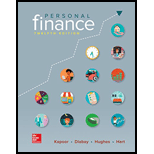
Case summary:
J and M is married couple. They have eight year old child. They also have $110,000 and $6,000 as debt for house and auto loan. All the payment for furniture has been made but they have debt on credit card worth $4,520. J earns $60,000 a year and M earns $16,000 a year. Six months ago, suddenly their air conditioner stopped cooling. When they call for technician and when technician checked, he founded that the compressor is broken and it would cost them $1,600 for repairs as warranty period was expired three months ago, they had to pay the bill from their savings account. The money that was in savings account is for vacation and the situation that they are not able to take the vacation worked as a wakeup call for them and forced them to think something about spending and investing habits. They decided to check their past expenses. They found extra spending of $220 every month. They started to put that money into the savings account to replace the fund that they had taken for air conditioner repairs.
Character in this case: J and M.
Adequate information: Home loan is $110,000.
Auto loan is $6,000.
Yearly earning for J is $60,000.
Yearly earning for M is $16,000.
Amount in savings account before repair expense is $2,000.
Air Conditioner repair cost is $1,600.
Amount in savings account after repair expense is $400.
Total take home pay is $4,520.
Total expenses are $4,300.
Monthly savings is $220.
Electricity is $240.
Family clothing allowance is $230.
Recreation and entertainment is $700.
Gift and donations are $350.
To determine: The expenses that can be reduced to increase the surplus.
Want to see the full answer?
Check out a sample textbook solution
Chapter 13 Solutions
Loose Leaf for Personal Finance
- finance subjectarrow_forwardCould you help explain, what is the complete salary survey analysis, and ensuring the data is relevant and up-to-date? What is the job evaluation and compensation plan? How to ensure the final report is comprehensive, clearly structured, and aligned with the company vision?arrow_forwardThe maturity value of an $35,000 non-interest-bearing, simple discount 4%, 120-day note is:arrow_forward
- Carl Sonntag wanted to compare what proceeds he would receive with a simple interest note versus a simple discount note. Both had the same terms: $18,905 at 10% for 4 years. Use ordinary interest as needed. Calculate the simple interest note proceeds. Calculate the simple discount note proceeds.arrow_forwardWhat you're solving for Solving for maturity value, discount period, bank discount, and proceeds of a note. What's given in the problem Face value: $55300 Rate of interest: 10% Length of note: 95 days Date of note: August 23rd Date note discounted: September 18th Bank discount rate:9 percentarrow_forwardAll tutor giving incorrect solnarrow_forward
 Essentials Of InvestmentsFinanceISBN:9781260013924Author:Bodie, Zvi, Kane, Alex, MARCUS, Alan J.Publisher:Mcgraw-hill Education,
Essentials Of InvestmentsFinanceISBN:9781260013924Author:Bodie, Zvi, Kane, Alex, MARCUS, Alan J.Publisher:Mcgraw-hill Education,

 Foundations Of FinanceFinanceISBN:9780134897264Author:KEOWN, Arthur J., Martin, John D., PETTY, J. WilliamPublisher:Pearson,
Foundations Of FinanceFinanceISBN:9780134897264Author:KEOWN, Arthur J., Martin, John D., PETTY, J. WilliamPublisher:Pearson, Fundamentals of Financial Management (MindTap Cou...FinanceISBN:9781337395250Author:Eugene F. Brigham, Joel F. HoustonPublisher:Cengage Learning
Fundamentals of Financial Management (MindTap Cou...FinanceISBN:9781337395250Author:Eugene F. Brigham, Joel F. HoustonPublisher:Cengage Learning Corporate Finance (The Mcgraw-hill/Irwin Series i...FinanceISBN:9780077861759Author:Stephen A. Ross Franco Modigliani Professor of Financial Economics Professor, Randolph W Westerfield Robert R. Dockson Deans Chair in Bus. Admin., Jeffrey Jaffe, Bradford D Jordan ProfessorPublisher:McGraw-Hill Education
Corporate Finance (The Mcgraw-hill/Irwin Series i...FinanceISBN:9780077861759Author:Stephen A. Ross Franco Modigliani Professor of Financial Economics Professor, Randolph W Westerfield Robert R. Dockson Deans Chair in Bus. Admin., Jeffrey Jaffe, Bradford D Jordan ProfessorPublisher:McGraw-Hill Education





